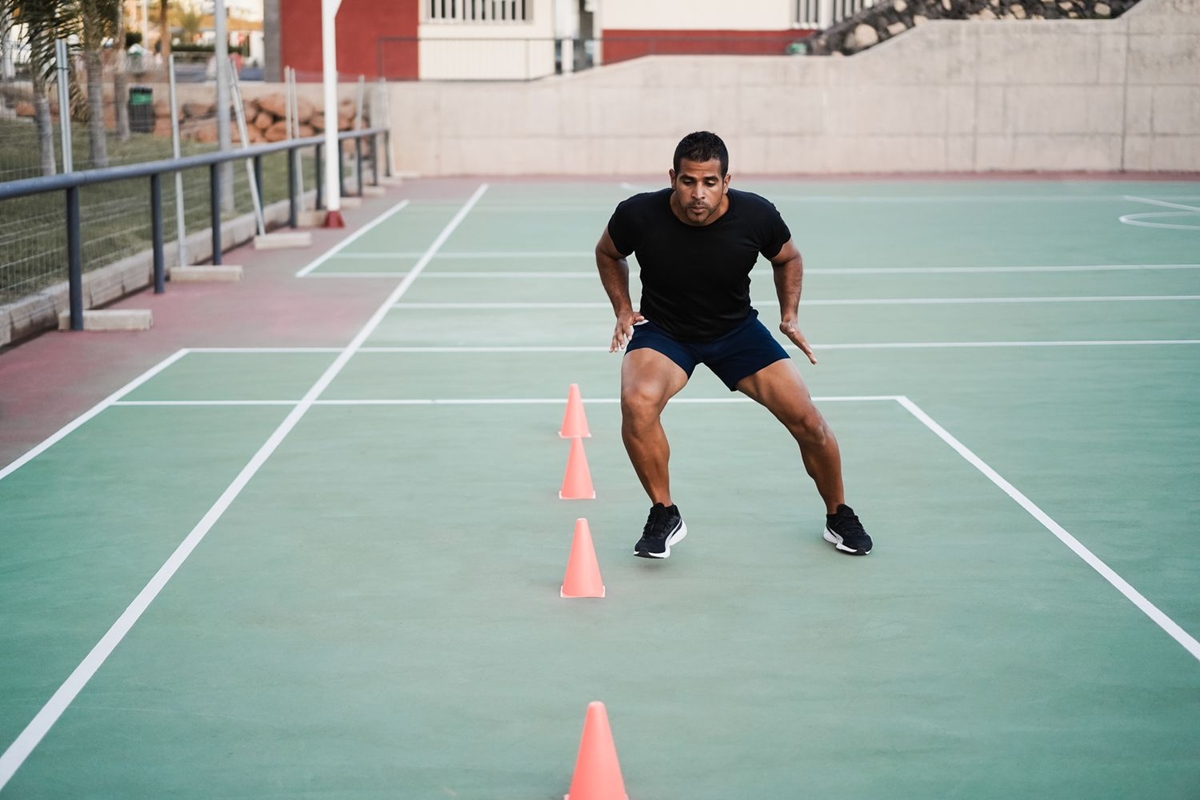

Featured
What Is A Tabata Workout
Modified: January 22, 2024
Looking for an intense and effective workout? Discover what a Tabata workout is and how it can help you achieve your fitness goals. Featured in this guide.
Introduction
Welcome to the world of high-intensity fitness training! If you’re looking to amp up your workouts and achieve maximum results in a short amount of time, then Tabata training might be just what you need. Tabata workouts have gained significant popularity in recent years for their effectiveness in burning calories, improving cardiovascular fitness, and increasing overall strength and endurance.
Named after Japanese scientist Dr. Izumi Tabata, who studied the effects of high-intensity interval training (HIIT), Tabata workouts are designed to push your body to its limits through brief, intense bursts of exercise followed by short rest periods. This form of training has been proven to provide numerous health benefits and is a favorite among fitness enthusiasts, athletes, and even those with limited time for exercise.
If you’re tired of spending hours at the gym or are looking to break through a plateau in your current routine, Tabata workouts offer a quick and efficient solution. Whether you’re a beginner or a seasoned fitness enthusiast, incorporating Tabata into your exercise regimen can take your fitness journey to new heights.
In this article, we will explore the history of Tabata, discuss what a Tabata workout entails, outline the benefits of this training method, provide guidance on how to properly execute a Tabata workout, offer a sample routine, and share common mistakes to avoid and safety precautions to keep in mind. By the end of this article, you’ll have all the information you need to start incorporating Tabata training into your fitness routine and reap the rewards it has to offer.
History of Tabata
The Tabata training method traces its origins back to the 1990s when Dr. Izumi Tabata and a team of researchers from the National Institute of Fitness and Sports in Tokyo conducted a study to compare the effects of moderate-intensity endurance training with high-intensity interval training.
Dr. Tabata and his team conducted their study on a group of elite athletes. The participants were divided into two groups, with one group performing high-intensity interval training and the other group engaging in moderate-intensity endurance training. The high-intensity interval training group performed four-minute workouts, alternating between 20 seconds of maximum effort exercise and 10 seconds of rest.
The study’s results were groundbreaking. It was found that the high-intensity interval training group experienced significant improvements in both aerobic and anaerobic fitness compared to the moderate-intensity endurance training group. The Tabata protocol proved to be highly effective in improving cardiovascular capacity and overall athletic performance.
Since its inception, the Tabata training method has gained popularity worldwide, becoming a go-to workout for athletes, fitness enthusiasts, and trainers alike. Its simplicity and efficiency make it an attractive option for those looking to maximize their workout in a minimal amount of time.
Today, the principles of Tabata training have been adapted and applied to various exercise modalities, including cardio exercises, strength training exercises, and even bodyweight movements. It has become a staple in the fitness industry, and countless individuals have achieved remarkable fitness transformations through the use of Tabata workouts.
While the original Tabata study focused on elite athletes, the method has since been modified to accommodate individuals of all fitness levels. This adaptability has contributed to its widespread popularity, making it accessible and beneficial for everyone, regardless of their fitness background.
The evolution and widespread adoption of the Tabata training method are a testament to its effectiveness in improving fitness levels and achieving results. As we dive deeper into what a Tabata workout entails, you’ll discover the specifics of this training method and how you can incorporate it into your fitness routine.
What is a Tabata Workout?
A Tabata workout is a form of high-intensity interval training (HIIT) that follows a specific protocol developed by Dr. Izumi Tabata. It involves performing short bursts of intense exercise followed by even shorter periods of rest. Typically, a Tabata workout lasts for a total of four minutes, consisting of eight rounds of intense exercise and rest intervals.
During a Tabata workout, each round consists of 20 seconds of all-out effort, pushing yourself to your maximum capacity. This is followed by a 10-second rest period, allowing for brief recovery before the next round. The workout is repeated eight times, totaling four minutes.
The beauty of Tabata workouts lies in their efficiency. Although they are short in duration, they are incredibly intense, challenging the cardiovascular system and working multiple muscle groups simultaneously. This type of training stimulates both aerobic and anaerobic pathways, leading to increased calorie burn, improved endurance, and enhanced overall fitness levels.
Tabata workouts can be customized to suit individual fitness goals and preferences. They can incorporate a wide range of exercises, such as bodyweight movements, cardio exercises like burpees and jumping jacks, as well as resistance training exercises using weights or resistance bands.
One important principle of Tabata training is maintaining proper form and technique throughout each exercise. Because of the high-intensity nature of the workouts, it’s crucial to prioritize safety and avoid compromising form for the sake of speed or intensity. This ensures that you maximize the effectiveness of the exercise while minimizing the risk of injury.
While a four-minute workout may sound easy compared to longer cardio sessions or weightlifting sessions, don’t be deceived. Tabata workouts are designed to push your limits and elicit a powerful physiological response from your body. The intense intervals combined with short recovery periods keep your heart rate elevated, boosting your calorie burn and improving cardiovascular fitness in a fraction of the time.
Now that you understand the basics of what a Tabata workout is, let’s explore the incredible benefits this training method offers and how it can help you achieve your fitness goals.
Benefits of Tabata Training
Tabata training offers a multitude of benefits that can positively impact your fitness journey. Here are some of the key advantages of incorporating Tabata workouts into your exercise routine:
- Time-efficiency: One of the most significant benefits of Tabata training is its efficiency. With just four minutes of intense exercise, you can achieve a high level of calorie burn, cardiovascular conditioning, and muscle engagement. This makes Tabata workouts ideal for those with busy schedules who want to maximize their workout in a short amount of time.
- Increased calorie burn: Tabata workouts are highly effective in burning calories. The intense intervals followed by short rest periods create an “afterburn” effect known as excess post-exercise oxygen consumption (EPOC). This means that even after you’ve finished your workout, your body continues to burn calories at an elevated rate to replenish energy stores and restore oxygen levels to normal.
- Improved cardiovascular fitness: Tabata training is an excellent way to boost your cardiovascular endurance. The intense bursts of exercise followed by short rests challenge your heart and lungs, promoting cardiovascular strength and efficiency. Over time, this can lead to improved stamina and endurance during various physical activities.
- Enhanced anaerobic capacity: Tabata workouts target both aerobic and anaerobic pathways. The short, intense intervals push your body’s anaerobic capacity—the ability to work at high intensity without relying on oxygen—resulting in increased muscle strength and power. This can be beneficial for athletes participating in sports that require short bursts of explosive movements.
- Muscle toning and strength gains: Tabata workouts engage multiple muscle groups, providing a full-body workout. The combination of high-intensity exercise and resistance training stimulates muscle growth and strengthens the muscles involved, leading to improved muscle tone, definition, and overall strength.
- Increased metabolic rate: Tabata training can elevate your metabolism for hours post-workout. The intense intervals requi
How to do a Tabata Workout
Doing a Tabata workout is relatively simple, but it requires focus and intensity. Here’s a step-by-step guide to help you get started:
- Select your exercises: Choose four to eight exercises that target different muscle groups or engage different movement patterns. This variety will ensure a well-rounded full-body workout. Examples of exercises include squat jumps, burpees, mountain climbers, push-ups, high knees, and plank jacks.
- Prepare your timer: To track the intervals accurately, set up a timer with intervals of 20 seconds of work and 10 seconds of rest. There are several smartphone apps or online timers specifically designed for Tabata workouts that you can use.
- Warm up: Before diving into the intense workout, it’s essential to warm up your body. Spend 5 to 10 minutes performing light cardio exercises such as jogging in place, jumping jacks, or dynamic stretches to increase your heart rate and prepare your muscles for the upcoming workout.
- Begin the workout: Once you’re warmed up, start your first round of exercise. Perform the chosen exercise at maximum intensity for 20 seconds, giving it your all. Focus on maintaining proper form and technique throughout the exercise.
- Rest: After completing the 20 seconds of exercise, allow yourself a 10-second rest period. Use this time to catch your breath and recover before moving on to the next exercise.
- Repeat the cycle: Repeat the cycle of 20 seconds of exercise and 10 seconds of rest for a total of eight rounds. Progress from one exercise to the next, ensuring you work all the chosen exercises in a balanced manner.
- Cool down: Once you’ve completed all the rounds, it’s important to cool down your body. Spend 5 to 10 minutes performing low-intensity exercises like walking, stretching, or foam rolling to gradually bring your heart rate down and allow your muscles to recover.
Remember, the key to a successful Tabata workout is maintaining the intensity throughout each 20-second interval. Push yourself to your limits during the exercise periods, but also listen to your body and modify the exercises if needed. As you become more comfortable with Tabata training, you can increase the number of rounds or the duration of the workout to continue challenging yourself.
Now that you know how to perform a Tabata workout, let’s take a look at a sample Tabata routine to give you an idea of how to structure your own workouts.
Sample Tabata Workout Routine
To give you an idea of how to structure your Tabata workouts, here is a sample routine incorporating a variety of exercises. Remember to warm up before starting and cool down afterward. Adjust the intensity and duration based on your fitness level and preferences:
- Jump Squats: Perform jump squats for 20 seconds, aiming to jump explosively, landing softly, and lowering into a deep squat position between jumps. Rest for 10 seconds.
- Push-ups: Transition to push-ups and perform as many reps as possible with proper form for 20 seconds. Lower your chest to the ground, keeping your core engaged. Rest for 10 seconds.
- Mountain Climbers: Move into mountain climbers, driving your knees toward your chest in a quick and controlled manner for 20 seconds. Maintain a straight line from head to heels. Rest for 10 seconds.
- Burpees: Next, perform burpees for 20 seconds, starting in a standing position, moving into a squat, kicking your legs back into a push-up position, performing a push-up, and jumping explosively back up. Rest for 10 seconds.
- High Knees: Transition into high knees, jogging in place, lifting your knees as high as possible, and pumping your arms for 20 seconds. Rest for 10 seconds.
- Plank Jacks: Move into plank jacks, starting in a plank position and jumping your feet out to the sides while maintaining a strong core for 20 seconds. Rest for 10 seconds.
- Squat Thrusts: Perform squat thrusts for 20 seconds, starting in a standing position, squatting down, placing your hands on the floor, kicking your legs back into a plank position, and jumping your feet back up to your hands before standing up again. Rest for 10 seconds.
- V-Sit Hold: Finish the Tabata workout routine with a core exercise. Sit on the floor, leaning back slightly, straighten your legs, and raise them off the ground, forming a V shape with your body. Hold this position for 20 seconds, engaging your core. Rest for 10 seconds.
Repeat this circuit of eight exercises twice, totaling a four-minute Tabata workout. As you progress, you can increase the intensity or duration of the workout by adding more rounds or incorporating more challenging exercises.
Remember, it’s essential to listen to your body and adjust the workout to your fitness level and abilities. If any exercise causes pain or discomfort, modify or choose an alternative movement that works for you.
Now that you have a sample Tabata workout routine, let’s discuss some common mistakes to avoid for a safe and effective workout.
Common Mistakes to Avoid in Tabata Workouts
While Tabata workouts are highly effective when done correctly, it’s important to be aware of common mistakes that can hinder your progress or lead to injury. By avoiding these pitfalls, you can ensure a safe and effective Tabata workout. Here are some common mistakes to watch out for:
- Neglecting proper form: It’s crucial to maintain proper form and technique throughout each exercise. Avoid rushing through the movements and focus on engaging the correct muscles. Sacrificing form for speed or intensity not only reduces the effectiveness of the exercise but also puts you at risk of injury.
- Starting with excessive intensity: While it’s important to give your all during the 20-second intervals, avoid starting with maximum intensity right from the beginning. Gradually build up your effort level as you progress through the rounds to prevent early fatigue and maintain form.
- Skipping the warm-up and cool-down: Neglecting to warm up before a Tabata workout can increase the risk of injury. Take the time to properly warm up your muscles and prepare your body for the intense exercise ahead. Similarly, cooling down afterward allows for proper recovery and reduces post-workout muscle soreness.
- Not modifying exercises when needed: Tabata workouts can be challenging, especially for beginners. If an exercise is too difficult or causes discomfort, it’s important to modify or choose an alternative movement that works for you. Listen to your body and make adjustments as necessary to ensure a safe and effective workout.
- Overdoing it: Tabata workouts are meant to be intense, but it’s essential to listen to your body and avoid overexertion. Pushing yourself to the limits is important, but pushing beyond your capacity can lead to burnout, increased risk of injury, and hinder progress. Allow yourself time for rest and recovery between Tabata workouts.
- Lack of variety: While Tabata workouts can be effective, performing the same exercises repeatedly can lead to boredom and plateau in your progress. Incorporate a variety of exercises that target different muscle groups to keep your workouts enjoyable and challenging.
- Focusing solely on Tabata workouts: While Tabata training can be a great addition to your fitness routine, it’s important to include other forms of exercise as well. Incorporate strength training, cardiovascular exercises, and flexibility work to maintain a well-rounded fitness regimen.
Avoiding these common mistakes will help you get the most out of your Tabata workouts, ensuring both safety and effectiveness. By maintaining proper form, progressing at a suitable pace, and listening to your body, you’ll be able to achieve optimal results and continue to progress on your fitness journey.
Now that you have a grasp of the common mistakes to avoid, let’s discuss some safety precautions to keep in mind during Tabata training.
Safety Precautions for Tabata Training
Tabata training is a highly intense workout method that requires focus and proper execution to ensure safety. Here are some important safety precautions to keep in mind when engaging in Tabata workouts:
- Consult with a healthcare professional: Before starting any new exercise program, especially if you have any pre-existing health conditions or injuries, it’s important to consult with a healthcare professional. They can assess your fitness level and provide guidance on appropriate modifications or exercises.
- Start at your fitness level: Tabata workouts can be challenging, especially for beginners. Start at a level that is appropriate for your current fitness level and gradually increase the intensity and duration of your workouts over time. It’s essential to build a strong foundation before pushing yourself too hard.
- Warm up properly: Begin each Tabata workout with a thorough warm-up to prepare your muscles and joints for the upcoming intensity. Incorporate dynamic stretches, light cardio exercises, and mobility drills to increase blood flow and flexibility.
- Pay attention to form: Proper technique is crucial in Tabata workouts to avoid injury. Focus on maintaining correct posture and alignment throughout each exercise. If you’re unsure about proper form, consider working with a qualified fitness professional who can provide guidance.
- Listen to your body: It’s important to pay attention to your body and respect its limits. If you experience pain, dizziness, or any other concerning symptoms during a Tabata workout, stop immediately and seek medical advice if needed. Push yourself, but not to the point of exhaustion or injury.
- Stay hydrated: Hydration is key during any workout, including Tabata training. Drink water before, during, and after your workout to stay properly hydrated and replace any fluids lost through sweat.
- Use proper equipment and attire: Ensure that you have the necessary equipment and attire for your Tabata workouts. Wear comfortable and supportive shoes, clothing that allows for ease of movement, and any required safety equipment, such as gloves or knee pads.
- Rest and recover: Tabata workouts are intense, and it’s crucial to allow your body enough time to rest and recover between sessions. Avoid overtraining and listen to your body’s signals for when it’s time to take a break or modify the intensity of your workouts.
By following these safety precautions, you can minimize the risk of injuries and ensure a safe and effective Tabata training experience. Always prioritize your well-being and make adjustments as necessary to suit your individual fitness level and needs.
Now that you understand the safety measures, let’s discuss who should and should not engage in Tabata workouts.
Who Should (and Should Not) Do Tabata Workouts
Tabata workouts can be a great addition to many fitness routines, but it’s important to consider your personal circumstances and fitness level. Here’s a breakdown of who should and should not engage in Tabata workouts:
- Who should do Tabata workouts:
- – Individuals with a moderate to high fitness level: Tabata workouts are intense and require a certain level of fitness. If you have been regularly exercising and have a good cardiovascular base, Tabata can be an effective next step to challenge yourself.
- – Those seeking time-efficient workouts: Tabata workouts are ideal for individuals with busy schedules who want to maximize their workout in a short amount of time. If you’re looking for a quick and effective way to burn calories and improve fitness, Tabata can be a great option.
- – Athletes looking to improve performance: Tabata training has been used by athletes to enhance their athletic performance. If you participate in sports that require short bursts of intense effort, such as sprinting or martial arts, Tabata can help improve your anaerobic capacity and power.
- Who should approach Tabata workouts with caution:
- – Beginners or individuals with low fitness levels: Tabata workouts are highly intense, and beginners may initially find them too challenging. It’s important to gradually build up your fitness level before diving into Tabata training. Starting with lower intensity workouts and gradually increasing the intensity can help avoid injuries.
- – Individuals with certain health conditions: If you have pre-existing health conditions such as heart disease, high blood pressure, respiratory issues, or joint problems, it’s important to consult with a healthcare professional before attempting Tabata workouts. They can provide guidance on safety considerations and modifications to exercises.
- Who should not do Tabata workouts:
- – Individuals with injuries or chronic pain: Tabata workouts can be high-impact, and individuals with injuries or chronic pain should avoid exercises that may aggravate their condition. It’s important to focus on exercises that promote healing and work within the limits of your body.
- – Pregnant women: During pregnancy, it’s essential to prioritize exercises that are safe for both the mother and the baby. Tabata workouts may not be suitable during pregnancy due to the intensity and potential impact on the body. Consult with a healthcare professional for appropriate exercise recommendations.
- – Individuals with certain medical conditions: If you have any specific medical conditions that may be exacerbated by intense exercise, such as uncontrolled diabetes, kidney disease, or any condition that affects your ability to engage in high-intensity exercise, Tabata workouts may not be appropriate. Consult with a healthcare professional for personalized advice.
It’s crucial to listen to your body, respect your limitations, and make informed decisions when incorporating Tabata workouts into your fitness routine. Remember to start gradually, prioritize safety, and modify exercises as needed to suit your individual needs and capabilities.
Now that you have an understanding of who should and should not engage in Tabata workouts, let’s conclude by summarizing the key points covered in this article.
Conclusion
Tabata training is a powerful and time-efficient workout method that can deliver incredible results. In just four minutes, this high-intensity interval training (HIIT) approach can help you burn calories, improve cardiovascular fitness, and increase overall strength and endurance. It allows you to push your limits and challenge your body in a short amount of time.
With its origins in the research of Dr. Izumi Tabata, this training method has gained popularity worldwide due to its effectiveness and adaptability. Whether you’re a beginner or an experienced fitness enthusiast, Tabata workouts can be customized to suit your fitness level and goals.
Incorporating a diverse range of exercises and focusing on maintaining proper form and technique are key to reaping the benefits of Tabata training while avoiding common mistakes and potential injuries. It’s important to warm up properly, listen to your body, and gradually increase the intensity to prevent burnout or overexertion.
While Tabata workouts can benefit many individuals, it’s essential to consider your personal circumstances and fitness level. Beginners or individuals with certain health conditions should approach Tabata with caution, and consulting with a healthcare professional is advised. Pregnancy and certain medical conditions may require modifications or alternative forms of exercise.
Tabata training provides a time-efficient, intense, and effective way to enhance your fitness level, burn calories, and improve your overall well-being. By incorporating Tabata workouts into your fitness routine while prioritizing safety and proper technique, you can achieve remarkable results and take your fitness journey to new heights.
So, why not give Tabata training a try? Challenge yourself, push your boundaries, and experience the transformative power of this high-intensity workout method. Get ready to sweat, feel the burn, and see the incredible benefits that Tabata has to offer.









